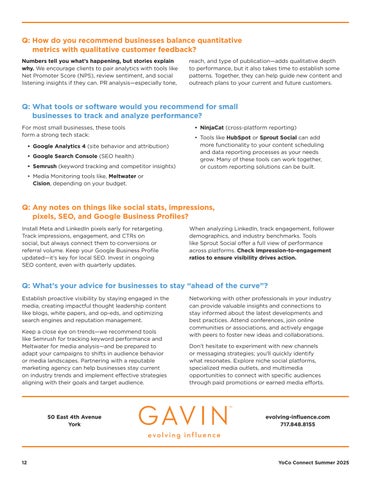









































Brendan Salyards | Manager,

Tackling


The opinions expressed in this material are for general information only and are not intended to provide specific advice or recommendations for any individual.
All rights reserved. No portion of this publication may be reproduced electronically or in print without the express written permission of the publisher.
This publication is produced in partnership with Tetra Creative Studio (tetracreative.studio).
Copyright © 2025 York County Economic Alliance. All rights reserved. No portion of this publication may be reproduced, in whole or in part, without the specific written permission of the York County Economic Alliance.




Advertising Contact Jessica Delp | jdelp@yceapa.org





Q: What is your role with the YCEA?
As Economic Initiatives Manager, I split my time between overseeing and advancing the York County Economic Action Plan, General Advocacy & Municipal Outreach, the York County Trail Towns Program, and, as of Fall 2024, administration for the York County Land Bank Authority. I wear a lot of hats.
Q: What inspires you about the work that the YCEA does?
YCEA is dedicated to making the lives of all York Countians better, regardless of where they live in the 911 square mile area that we all call home. We make a real difference in the lives of folks who live here; that’s pretty cool.
Q: What brought you to York County?
I moved to York County in the Summer of 2022, after taking the job with YCEA, I committed to York with the zeal of a convert. We’ve got a great team, and I enjoy the work that we’re doing.
Q: What do you enjoy most about what York County has to offer?
York County has a little bit of everything. There’s an urban center at the core, and it is very rural in other areas. It’s one of the joys of the job to be able to drive through rural York County on a nice day and enjoy the landscape.
Q: A favorite non-office place to host meetings?
Downtown, my go-to is Gather 256. In Eastern York County, when the weather is good, the pavilion at Flinchbaugh’s Orchard & Farm Market is a great place to host a meeting.

Q: How do you enjoy your downtime in the County?
While the Masonic Lodge where I’m currently serving as the elected Junior Warden is in Gettysburg (Good Samaritan Lodge No. 336), our larger district covers both Adams and York Counties, and I’m a member of several Masonic organizations here. I am an active member of York Chapter 199, York-Gethsemane Commandery No. 21, and the Red Lion Scottish Rite Club. I’m also currently an elected officer in York Council No. 21.
Q: For someone interested in relocating to York County, what would be your selling points to them?
York County is more affordable than many of our surrounding competitors, and it’s got a great mix of urban, suburban, and rural areas. There’s plenty to do in the County and we’re blessed with a great network of four and a half State Parks, 11 (soon to be 12) County Parks, and a great network of municipal parks, too. I’ve found folks to be welcoming. It’s a great place to live.
Q: What is a recommended/must-do activity for someone visiting the area?
Visiting at least one of our seven York County Trail Towns is a must-do.
Q: What is a hidden gem you enjoy that you think most people might not know about?
Folks who are new to York may not know that there’s a great vista from Greenhill Road near Mount Rose Cemetery where you can look over York and get a great panorama of the metro area.
By Megan Kreiser Assistant Vice President, Events
York County is at a crossroads. As industrial development accelerates and the demand for labor intensifies, a critical challenge has emerged: Where will this workforce reside?
Real estate professionals and economic development leaders are sounding the alarm that the availability of attainable workforce housing is becoming a bottleneck in York County’s continued growth. "It's not always framed as a housing issue," says Kevin Hodge, brokerage advisor with ROCK Commercial Real Estate, "but when employers say they can’t find people, housing is absolutely part of that conversation." For example, fulfillment centers and warehouses now employ thousands where they once employed hundreds, compounding housing pressure in already tight markets
The YCEA identified similar concerns through the recently conducted housing study as part of the York County Economic Action Plan. Along with our partners, we’ve created a quarterly Housing Developers Roundtable to provide a forum for information sharing and issue identification amongst the public and private residential development and construction community. Another key action step is engaging employers in supporting housing access to support workforce development.


The housing study also identified the need to invest in workforce training to support indemand construction careers, as material and labor costs have skyrocketed, making it harder to build affordable homes under traditional models. In that same vein, there is a need to educate and promote the need for middle housing development through local zoning recommendations. For decades, local zoning ordinances have favored large-lot, single-family developments. But the math no longer works.
“Unless you're adding capacity, you're just rearranging the chairs on the Titanic,” mentioned Kevin Hodge. Indeed, new highend units contribute to a “trickle-down” effect, freeing up more affordable apartments as people move up the housing ladder.
Yet outdated local ordinances are still a barrier. Parking mandates, density caps, and a default to “no” rather than “let’s figure it out” stifle innovation. Municipalities are urged to reevaluate long-held requirements and instead find ways to say yes. In some cases, developers are proposing creative solutions, like basement parking, to meet regulations while still building needed housing.


"...when employers say they can’t find people, housing is absolutely part of that conversation."
Kevin Hodge Brokerage Advisor with ROCK Commercial Real Estate
Zoning reform is especially crucial for unlocking “middle housing” options like duplexes, triplexes, and townhomes, which are both more affordable and more aligned with shifting demographics and household sizes.
A central solution lies in increasing the capacity of the housing market—specifically, allowing for greater residential density. Fortunately for York County, we do have developers in York focused on these high-density residential projects. Jordan Ilyes, owner of Ilyes Holdings LLC, has focused on revitalizing small towns such as Red Lion and Hanover. Most recently, Ilyes completed a 190unit apartment complex on Franklin Street in York, demonstrating that demand exists when municipalities cooperate. “YoCo has a rich heritage of beautiful architecture and industrial buildings,” shares Ilyes. “Red Lion with all of its cigar and furniture factories is ripe for redevelopment of these buildings. I’m honored to be able to pioneer these projects and partner with the community to be a catalyst for the economy.”



Adding to the complexity are community concerns, often around schools, traffic, or changes to neighborhood character. But as Kevin’s expert explained it, “People don’t want a warehouse behind them, but they want their package faster.” Reconciling these tradeoffs requires educating both residents and local leaders on the economic benefits of smart growth and higher density.
York is also increasingly serving as a bedroom community for higher-cost cities like Baltimore and D.C., especially in areas like New Freedom. The challenge will be ensuring that new residents also support local economies, not just sleep in York but shop, dine, and invest here too.
The road ahead requires strategic cooperation across the private and public sectors. As York County leaders look to the future, the path is clear: promote zoning flexibility, encourage employer engagement, allow density to meet demand, and reframe housing as economic infrastructure. That’s how York can remain not just a place to work, but a place to thrive.
To learn more about the York County Economic Action Plan, visit yorkcountyeap.org.


Jordan Ilyes Owner of Ilyes Holdings LLC













A nationally ranked brand strategy firm, GAVIN™ started its agency story in York, PA, and has grown to serve clients coast-to-coast with multiple offices and teammates across the country. The team has been recognized by dozens of top business and marketing industry media for their growth, team culture, and comprehensive marketing and communications services, delivering high-performance outcomes for their clients.
Q: What metrics and data should businesses be tracking?
Every business should begin with a solid foundation of performance metrics spanning visibility and conversion channels. Key metrics might include monthly or quarterly website traffic sources, lead form conversions, media coverage volume, and engagement across owned social platforms. For those with the resources to dive deeper, many other metrics and tools are available to measure the success of digital marketing efforts. A few examples include:
• Keywords: Gauge the effectiveness of your SEO strategy.
• Email Open and Click-Through Rates: Insights into messaging performance based on monitoring.
• Conversion Rate Optimization (CRO): Testing website elements (design, user experience) to boost conversion rates.
• Customer Lifetime Value (CLV): Average revenue per customer, guiding acquisition and retention.
• Return on Investment (ROI): Measures investment profitability; tracks effective revenue-driving channels.
• Social Media Engagement: Analyzes likes, comments, and shares to understand audience connection with your brand.
These metrics help paint a fuller picture of performance. Digital marketing isn’t just about driving clicks; it’s about how your audience discovers, trusts, and engages with your brand.
Q: Are there common metrics that businesses often overlook, or mistakes they make?
Absolutely. Branded keyword growth is often overlooked, yet it’s a powerful indicator of brand awareness driven by PR efforts and digital content. Another common mistake is failing to track post-click behavior—focusing solely on traffic metrics without analyzing what users do next or how to guide them toward conversion.
Marketing teams and leadership frequently prioritize topline numbers without questioning whether those metrics translate into meaningful business outcomes or contribute to the organization’s long-term growth and relevance.
Q: What information should businesses focus on most?
Focus on KPIs (key performance indictors) that align with short- and long-term business goals. For sales growth, track qualified leads and ROAS (return on assets). For visibility, monitor share of voice, sentiment, and engagement across channels.
The goal is to measure momentum—are people finding you, staying, and talking about you? Are they engaging to build a relationship or seeing value in your content that drives retention or spending?
Q: Once businesses have data, what should they do next?
Data should be at the core of your strategy, guiding optimizations and bringing you closer to your sales goals. For instance, if a press mention generates more organic traffic than your ad spend, it’s a clear sign to invest more in PR. If users bounce from your landing pages, it’s time to revisit the messaging or improve the user experience.
Changes don’t need to happen every month—adjustments take time to deliver results. However, regular evaluation is essential. Marketing is not a “set it and forget it” process. We recommend establishing consistent review cycles with your team or agency to uncover insights, refine strategies, and plan your next steps to drive meaningful results.
Q: What strategies help prioritize and focus on the most important metrics for a business's goals?
Align every metric with a clear business objective— whether it's building brand awareness, generating leads, or securing media coverage. Create a structured hierarchy: primary KPIs, supporting metrics, and diagnostic indicators. Let your data do more than just report numbers; use it to tell a compelling story.
What value did that new event bring to the organization? How did a fresh piece of content or a prominent feature in a key publication enhance your campaign's impact? Can these efforts continue to deliver results with further investment? Let strategy define what truly matters, rather than letting metrics drive the narrative.
Q: What are the most critical metrics in a business's first year vs. during its growth phase?
During a business's first year, the most critical metrics are typically focused on acquisition and customer retention. These would include metrics such as website traffic, lead generation, conversion rates, and customer lifetime value.
During the growth phase, a business typically prioritizes expanding its reach, boosting brand awareness, and optimizing for greater efficiency. Considering customer acquisition cost (CAC), return on ad spend (ROAS), and how brand equity (earned media and share of voice) supports retention and word-of-mouth referrals
for further expansion. It’s easy to become fixated on trying to do everything, but you need to build from a core set of data points and phase in metrics as you evolve and better understand where your customers, recruits, or partners are coming from.
It is important to note that every business is unique and may have different KPIs depending on its industry, target audience, and goals. It's essential to regularly review and adjust these metrics based on the current stage of the business and its objectives.

Q: How do you recommend businesses balance quantitative metrics with qualitative customer feedback?
Numbers tell you what’s happening, but stories explain why. We encourage clients to pair analytics with tools like Net Promoter Score (NPS), review sentiment, and social listening insights if they can. PR analysis—especially tone,
reach, and type of publication—adds qualitative depth to performance, but it also takes time to establish some patterns. Together, they can help guide new content and outreach plans to your current and future customers.
Q: What tools or software would you recommend for small businesses to track and analyze performance?
For most small businesses, these tools form a strong tech stack:
• Google Analytics 4 (site behavior and attribution)
• Google Search Console (SEO health)
• Semrush (keyword tracking and competitor insights)
• Media Monitoring tools like, Meltwater or Cision, depending on your budget.
• NinjaCat (cross-platform reporting)
• Tools like HubSpot or Sprout Social can add more functionality to your content scheduling and data reporting processes as your needs grow. Many of these tools can work together, or custom reporting solutions can be built.
Q: Any notes on things like social stats, impressions, pixels, SEO, and Google Business Profiles?
Install Meta and LinkedIn pixels early for retargeting. Track impressions, engagement, and CTRs on social, but always connect them to conversions or referral volume. Keep your Google Business Profile updated—it’s key for local SEO. Invest in ongoing SEO content, even with quarterly updates.
When analyzing LinkedIn, track engagement, follower demographics, and industry benchmarks. Tools like Sprout Social offer a full view of performance across platforms. Check impression-to-engagement ratios to ensure visibility drives action.
Q: What’s your advice for businesses to stay “ahead of the curve”?
Establish proactive visibility by staying engaged in the media, creating impactful thought leadership content like blogs, white papers, and op-eds, and optimizing search engines and reputation management.
Keep a close eye on trends—we recommend tools like Semrush for tracking keyword performance and Meltwater for media analysis—and be prepared to adapt your campaigns to shifts in audience behavior or media landscapes. Partnering with a reputable marketing agency can help businesses stay current on industry trends and implement effective strategies aligning with their goals and target audience.
50 East 4th Avenue
Networking with other professionals in your industry can provide valuable insights and connections to stay informed about the latest developments and best practices. Attend conferences, join online communities or associations, and actively engage with peers to foster new ideas and collaborations.
Don’t hesitate to experiment with new channels or messaging strategies; you’ll quickly identify what resonates. Explore niche social platforms, specialized media outlets, and multimedia opportunities to connect with specific audiences through paid promotions or earned media efforts.

evolving-influence.com 717.848.8155














The York County Economic Alliance (YCEA) is home to a host of data sources for businesses to make smart decisions based on the York County market and our advantages.

Data reporting is available for businesses to make decisions by providing foot traffic insights about visitors’ demographics and travel patterns, length of stay for visitors locals and from out-of-area, and an overall snapshot of visitors hip to your business for any day, week, or month from the past seven years. Data is generated by Placer.ai, a nationally utilized leader in visitor patterns and economic impact. Learn more at yceapa.org/insights.
The YCEA offers quarterly Economic Intelligence reports on the latest updates and trends on York County’s economy and the policies that impact our business community. Sent via email to over 6,000 members and stakeholders, businesses are invited to sign up online. Learn more at yceapa.org/insights.
Powered by Local Intel, this free, online tool is a living and breathing resource covering logistical, workforce, and market advantage of YoCo, industry insights, community facilities, land use, and transportation. View it at yceapa.org/economic-development/ additional-resources.
IMPLAN is a leading economic analysis platform. Our YCEA team can conduct an IMPLAN economic impact analysis that helps assess the economic and employment effects of your project on the local economy.

• Site Selector Profile is utilized by companies considering a relocation or expansion in York, while offering a snapshot of the benefits of York County.
• York County’s Arts, Culture, and Outdoor Recreation Ecosystem is always in the market to partner, the YCEA works closely with the Cultural Alliance of York County and others for comprehensive economic data.
• Firefly Consultancy, led by YCEA, is a tool that extends outside the County to provide a broad suite of services based on our experience with economic development and the outdoor sector. We are a trusted advisor to clients in need of boutique outdoor economy expertise.

Empower your team with job-ready credentials from Google, IBM, Meta, and more—delivered through York College of Pennsylvania’s Career Academy
Courses are 100% online, flexible, and designed for real life. Whether you’re upskilling one employee or your entire workforce, the Career Academy offers a practical and affordable way to invest in growth—right here in the York community.


By Brendan Salyards | Economic Initiatives Manager
In 2022, the York County Rail Trail Authority completed a study to analyze the use of the York County Heritage Rail Trail and the resulting economic impact from trail use.
While the analysis was sound, the economic impact estimate was based on the result of a single trail counter and the results of an online survey that was advertised along the trail. The study estimated that the annual number of uses was roughly 264,000 and that the total impact was between $2.6 million and $3.9 million. It was suspected at the time that this was an underestimate, but without additional data tools, there was no way to prove that hypothesis. Now, outfitted with data from Placer. ai, we construct a more accurate estimate of the number of visits and the economic impact of the York County Heritage Rail Trail.
Based on those metrics, previously described [see page 14], Placer.ai estimates that there were 468,200 visits in 2022 from 171,600 unique visitors. Over one and a half times the number estimated in the 2022 study. Furthermore, the Placer.ai estimate excludes trail-users in the City of York, where it is difficult to differentiate between individuals using the Heritage Rail Trail and generally moving across the City.
Placer.ai data gives us the ability to differentiate users between visitors and travelers (those who live over 50 miles away) who are highly likely to spend a night in York County during their trip. Based on this figure, we can estimate that there were a total of 27,530 tourism-based visits to the Heritage Rail Trail in 2022. The PA Department of Community & Economic Development estimated
that in 2021, Tourism travelers would spend an average of $388 per night on travel. Using this expenditure, we can estimate that the total tourism impact of the trail was $10.7 million in 2022. In addition to updated visitor numbers, Placer.ai gives us the power to see where folks came from and where they went before their trip on the Heritage Rail Trail.
The data also gives us the ability to verify where trail users went before and after their trip. While the 2022 study estimated that approximately 34.6% of trips resulted in soft goods purchases. Placer.ai data shows that trail users were visiting retail and dining establishments before 18.8% of their trips and after 22.3% of their trips. With this additional insight and our revised visitor data, we can more accurately estimate that trail users, residing within 50 miles of the trail, were making purchases that contributed to $8.1 million. Combined, this results in a total economic impact estimate of $18 million (4.5 times the original estimate) in York County just from the York County Heritage Rail Trail.
Based on the latest visitor numbers and accounting for inflation, we can estimate that the direct economic impact of the Heritage Rail Trail on the York County economy was $23.3 million in 2024. Analysis using Implan (an economic impact analysis tool) suggests that spending by the businesses making these sales would generate an additional $17.9 million in indirect and induced impact for a total economic impact of $41.2 million in 2024.
To learn more about the York County Trail Towns program, visit yorkcountytrailtowns.com




$41.2M $2.4M $23.3M $15.4M 2024 York County Heritage Rail Trail Economic Impact Analysis
NUMBER OF VISITS
NUMBER OF UNIQUE VISITORS 499,400 192,200
NUMBER OF VISITS FROM BEYOND 50 MILES ESTIMATED EXPENDITURE ON HARD GOODS ESTIMATED EXPENDITURE OF AN OVERNIGHT VISITOR ESTIMATED EXPENDITURE ON SOFT GOODS TOURISM IMPACT
29.5k $5.6M $12.3M
$419 $4.3M

ECONOMIC IMPACT
ECONOMIC IMPACT

Earlier this year, the BLOOM Bootcamp series kicked off with a presentation by Tannisha Fuentes, CEO and Founder of Your Employment Services, a boutique and tech-focused consulting firm in the City of York helping companies cultivate the talent they need to thrive. Read below for a Q&A with Tannisha with tips for small businesses on “how to grow their businesses with technology.”
In general, what does your work focus on, and how do you integrate technology into your services?
Through Your Employment Services, I provide staffing support to businesses, including recruitment, temporary staffing, temp-toperm placement, and direct hire services. In addition to staffing, I offer consulting support to help businesses create customized workforce strategies, improve retention, and explore upskilling opportunities for their teams.
We use basic, accessible systems that businesses and childcare providers can adopt easily. Tools like QuickBooks, Gusto, and Wave help manage payroll and expenses, while platforms similar to ATS (Applicant Tracking Systems) and HRIS (Human Resource Information Systems) assist in organizing hiring records, employee data, and onboarding workflows.
What is your recommendation for businesses that are not sure if technology can be used for their business?
Technology is evolving quickly, and staying up to speed is essential for long-term success. Even if your business has operated traditionally, integrating the right tech tools can make your operations more efficient and help you remain competitive. Businesses can use online tools for background checks, e-signatures, payroll, time tracking, and digital forms. Even simpler tools like Google Forms, JotForm, or Trello can improve workflow and reduce manual tasks. I recommend starting with one task that’s eating up time—whether it’s payroll, scheduling, or recordkeeping—and exploring a tool that can simplify that function. Staying relevant in today’s market often starts with adopting small but meaningful tech improvements.
How would a business leverage YOUR expertise and services?
Businesses can leverage my support in two primary ways:
(1) Staffing Solutions – I help businesses find the right talent through direct hire, temporary, and temp-to-perm placements.
(2) Workforce Consulting – I assist employers in building strategies to retain employees, adapt to evolving workforce trends, and explore upskilling options.
Hiring doesn’t have to be intimidating. My mission is to bridge the gap between employers and job seekers, helping business owners find qualified talent and build strong teams. With the right support, businesses can grow confidently and sustainably. If a business owner is looking for help in hiring or keeping good talent, I’m just an email or phone call away.
How has BLOOM supported you and the work you do?
BLOOM has been a pillar of support throughout every stage of my entrepreneurial journey—from the very first idea, through planning, growth, and expansion. They’ve provided access to resources, mentorship, networking opportunities, and even pathways to capital. BLOOM isn’t just a program—it’s a full ecosystem that supports the success of small businesses. I encourage every entrepreneur, especially those just starting out, to get connected.

Pennsylvania’s agencies and departments (pa.gov/agencies) host an assortment of relevant data, both statewide and at the county/local levels, that allow for economic insights. Frequent data sets we utilize include:
• The PA Department of Labor & Industry shares a monthly county profile that includes a statistical snapshot of top employers, unemployment rates, and wages by sectors.
• The PA Department of Community & Economic Development provides insights such as local and county tax rates, demographics, and trends in industry.


The federal government’s various agencies and departments share data that is readily accessible to the public. Two of our go-to sources include:
• The Bureau of Economic Analysis (bea.gov), a part of the U.S. Department of Commerce, provides useful data on GDP, consumer spending, trade, and industries, often in the form of data sets from national, state, regional, and metro areas.
• The Census Bureau (census.gov) is known as the source for all things data and is the country’s largest statistical agency, providing context on people and the economy. The census provides 2.5 million tables of raw data, along with quick facts on local data, profiles, economic indicators, and much more.
The use of data has been essential to the York County Economic Action Plan (EAP), the county’s economic competitiveness plan adopted in 2020 and which began implementation in 2021. The EAP calls out 142 action steps that cover the gamut of areas that contribute to our local economy. Workforce and economic mobility, quality of place, future of industry, rural economy, entrepreneurship, equity and inclusion, and infrastructure and the built environment are areas specifically called out in the plan, and YCEA, among several countywide partners, are identified to carry out the action steps.
The plan is nearing the 5th year of implementation and is undergoing a review and refresh. This allows for analysis on the plan’s impact at its midpoint and interjection of updated data and adjustments to priorities as the economic climate has shifted from adoption. The review of the EAP will be completed by the end of 2025.
To learn more, visit YorkCountyEAP.org

For details, visit yceapa.org
Thursday, July 17 | 5-7 pm
YCEA Mixer at Lavender Acres Winery presented by Murray 4865 Libhart MIll Road, Hellam Township
Wednesday, August 27 | 7:30-8:30 am
Transportation in York County, An Economic Insights Series event presented by Glatfelter Insurance Group Wyndham Garden York, 2000 Loucks Rd.
Tuesday, September 9 | 5-7 pm
WBCO Networking Event presented by McNees Wallace & Nurick
Bridgewater Public House, 601 Chestnut Hill Road
Wednesday, September 24 | 7:30-8:30 am
State of the County with York County Commissioners, An Economic Insights Series event presented by Glatfelter Insurance Group
Wyndham Garden York, 2000 Loucks Rd.


For details, visit downtownyorkpa.com
Friday, July 4 | 5-9 pm
First Friday presented by WellSpan Health: Beaver St. Barbeque with the York Revolution
Friday, August 1 | 5-9 pm
First Friday presented by WellSpan Health: Family Fun Daze
Thursday, August 7 | 6-8 pm
Downtown First Awards, presented by The Glatfelter Agency
Friday, September 5 | 5-9 pm
First Friday presented by WellSpan Health: Fall Fest
Don’t miss out on the fun of First Fridays in Downtown York, presented by WellSpan Health!
From 5-9 pm, downtown destinations host special events, offer refreshments and promotions, sponsor live entertainment, and much more! Check out all of the different happenings each month at downtownyorkpa.com/first-friday
We're reimagining how health care works. Now, let us work for you.
Backed by WellSpan Health, the region’s largest and most comprehensive health system whose roots are right here in central Pennsylvania, Well at Work provides smart employer solutions and programs designed to positively impact the cost and quality of your employees’ health.
Our services include: Let’s explore how we
Corporate wellness services featuring a wellness platform powered by WellRight, wellness coaching, biometric screening, flu vaccines and more
Employee Assistance Program powered by Quest Behavioral Health, supporting your employees’ mental health and wellbeing
Onsite and near-site clinics offering convenient, accessible care right where your employees need it
Direct Connect, our direct primary care solution, providing affordable and unlimited access to WellSpan primary care providers
Bundle program powered by MDsave, delivering cost savings for certain procedures provided by WellSpan
Occupational health services to manage workplace safety and your employees’ health
Get started by emailing
or call (717) 851-6981
